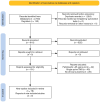Effects of repetitive transcranial magnetic stimulation in children and young people with psychiatric disorders: a systematic review
- PMID: 38809301
- PMCID: PMC11868357
- DOI: 10.1007/s00787-024-02475-x
Effects of repetitive transcranial magnetic stimulation in children and young people with psychiatric disorders: a systematic review
Abstract
Repetitive transcranial magnetic stimulation (rTMS) has demonstrated benefits in adults with psychiatric disorders, but its clinical utility in children and young people (CYP) is unclear. This PRISMA systematic review used published and ongoing studies to examine the effects of rTMS on disorder-specific symptoms, mood and neurocognition in CYP with psychiatric disorders. We searched Medline via PubMed, Embase, PsychINFO via OVID, and Clinicaltrials.gov up to July 2023. Eligible studies involved multiple-session (i.e., treatment) rTMS in CYP (≤ 25 years-old) with psychiatric disorders. Two independent raters assessed the eligibility of studies and extracted data using a custom-built form. Out of 78 eligible studies (participant N = 1389), the majority (k = 54; 69%) reported an improvement in at least one outcome measure of disorder-specific core symptoms. Some studies (k = 21) examined rTMS effects on mood or neurocognition,: findings were largely positive. Overall, rTMS was well-tolerated with minimal side-effects. Of 17 ongoing or recently completed studies, many are sham-controlled RCTs with better blinding techniques and a larger estimated participant enrolment. Findings provide encouraging evidence for rTMS-related improvements in disorder-specific symptoms in CYP with different psychiatric disorders. However, in terms of both mood (for conditions other than depression) and neurocognitive outcomes, evidence is limited. Importantly, rTMS is well-tolerated and safe. Ongoing studies appear to be of improved methodological quality; however, future studies should broaden outcome measures to more comprehensively assess the effects of rTMS and develop guidance on dosage (i.e., treatment regimens).
Keywords: Children; Psychiatric disorders; Systematic review; Young people; rTMS.
© 2024. The Author(s).
Conflict of interest statement
Declarations. Conflict of interest: The authors declare no conflict of interest.
Figures
References
-
- Belfer ML (2008) Child and adolescent mental disorders: the magnitude of the problem across the globe. J Child Psychol Psychiatry 49(3):226–236. 10.1111/j.1469-7610.2007.01855.x - PubMed
-
- Kieling C, Baker-Henningham H, Belfer M, Conti G, Ertem I, Omigbodun O, Rohde LA, Srinath S, Ulkuer N, Rahman A (2011) Child and adolescent mental health worldwide: evidence for action. Lancet 378(9801):1515–1525. 10.1016/S0140-6736(11)60827-1 - PubMed
-
- Polanczyk GV, Salum GA, Sugaya LS, Caye A, Rohde LA (2015) Annual Research Review: a meta-analysis of the worldwide prevalence of mental disorders in children and adolescents. J Child Psychol Psychiatry 56(3):345–365. 10.1111/jcpp.12381 - PubMed
-
- Ravens-Sieberer U, Erhart M, Devine J, Gilbert M, Reiss F, Barkmann C, Siegel NA, Simon AM, Hurrelmann K, Schlack R, Hölling H, Wieler LH, Kaman A (2022) Child and adolescent Mental Health during the COVID-19 pandemic: results of the three-Wave Longitudinal COPSY Study. J Adolesc Health 71(5):570–578. 10.1016/j.jadohealth.2022.06.022 - PMC - PubMed
Publication types
MeSH terms
Grants and funding
LinkOut - more resources
Full Text Sources
Medical


